- Books Name
- CBSE Class 7 Social Science Book
- Publication
- Param Publication
- Course
- CBSE Class 7
- Subject
- Social Science
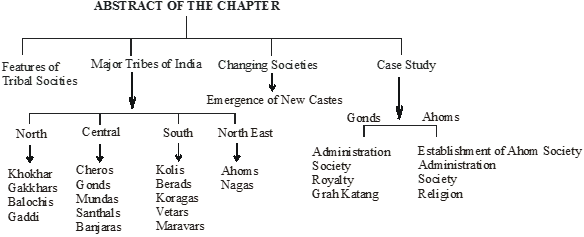
* INTRODUCTION
Many historians and social scientists appear to have accepted the notion that caste divisions in society is a unique.
In large parts of the subcontinent, society was already divided according to the rules of varna. These rules, as prescribed by the Brahmanas, were accepted by the rulers of large kingdoms. The difference between the high and low, and between the rich and poor, increased. Under the Delhi Sultans and the Mughals, this hierarchy between social classes grew further.
* Beyond Big Cities : Tribal Societies
Many societies in the subcontinent did not follow the social rules and rituals prescribed by the Brahmanas. Nor were they divided into numerous unequal classes. Such societies are often called tribes.
* Features of Tribal societies
(i) Members of each tribe were united by kinship bonds. Many tribes obtained their livelihood from agriculture. Others were hunter-gatherers or herders. Most often they combined these activities to make full use of the natural resources of the area in which they lived.
(ii) Some tribes were nomadic and moved from one place to another. A tribal group controlled land and pastures jointly, and divided these amongst households according to its own rules.
(iii) Many large tribes thrived in different parts of the subcontinent. They usually lived in forests, hills, deserts and places difficult to reach.
(iv) They clashed with the more powerful caste-based societies. In various ways, the tribes retained their freedom and preserved their separate culture. But the caste-based and tribal societies also depended on each other for their diverse needs.
* Who were Tribal People ?
(i) According to the Rig Veda and sacred texts dating back to oral traditions of more than 3,000 years ago, there existed four varnas in the Indian society where each group had a function in sustaining the life of society.
(ii) Ancient India mentions the existence of tribes in Mahabharata and in the edicts of King Ashoka.
(iii) These tribals find a mention as forest dwellers during the Mauryan times.
(iv) Historically, they have always existed beyond the mainstream society, guided and governed by their own sets of rules.
(v) Literally meaning ‘indigenous people’ or ‘original inhabitants’.
(vi) Contemporary historians and travellers give very scanty information about tribes. But they preserved rich customs and oral traditions. These were passed down to each new generation.
* Major Tribes In India
* Tribes of North India
(i) North west In Punjab, the Khokhar fourteenth centuries. Later, the Gakkhars became more important. Their chief, Kamal Khan Gakkhar, was made a noble (mansabdar) by Emperor Akbar.
(ii) In Multan and Sind, the Langahs and Arghuns dominated extensive regions before they were subdued by the Mughals.
(iii) The balochis were another large and powerful tribe in the North West. In the Western Himalaya lived the shepherd tribe of Gaddis.
* Tribes of North East India
The distant North-Eastern part of the subcontinent too was entirely dominated by tribes - the Nagas, Ahoms and many others.
* Tribes of Central India
(i) In many areas of present-day Bihar and Jharkhand, Chero chieftiens had emerged by the twelfth century.
(ii) The Mundas and Santhals were among the other important tribes that lived in this region and also in Orissa and Bengal.
(iii) The large tribe of Bhils was spread across Western and Central India.
(iv) The Gonds were found in great numbers across the present-day states of Chhattisgarh, Madhya Pradesh, Maharashtra and Andhra Pradesh.
* Tribes of South India
(i) The Maharashtra highlands and Karnataka were home to Kolis, Berads and numerous others.
(ii) Further South there were large tribal populations of Koragas, Vetars, Maravars and many others.
* How Nomads and Mobile Poeple Lived
(i) Nomadic pastoralists moved over long distances with their animals. They lived on milk and other pastoral products.
(ii) They also exchanged wool, ghee, etc., with settled agriculturists for grain, cloth, utensils and other products.
(iii) They bought and sold these goods as they moved from one place to another, transporting them on their animals.
(iv) The Banjaras were the most important trader nomads.
(v) Their caravan was called tanda.
(vi) Sultan Alauddin Khalji used the Banjaras to transport grain to the city markets.
(vii) Emperor Jahangir wrote in his memoirs that the Banjaras carried grain on their bullocks from different areas and sold it in towns.
(viii) They transported food grain for the Mughal army during military campaigns.
(ix) Many pastoral tribes reared and sold animals, such as cattle and horses, to the prosperous people. Different castes of petty pedlars also travelled from village to village.
(x) They made and sold wares such as ropes, reeds, straw matting and coarse sacks. Sometimes mendicants acted as wandering merchants.
(xi) There were castes of entertainers who performed in different towns and villages for their livelihood.
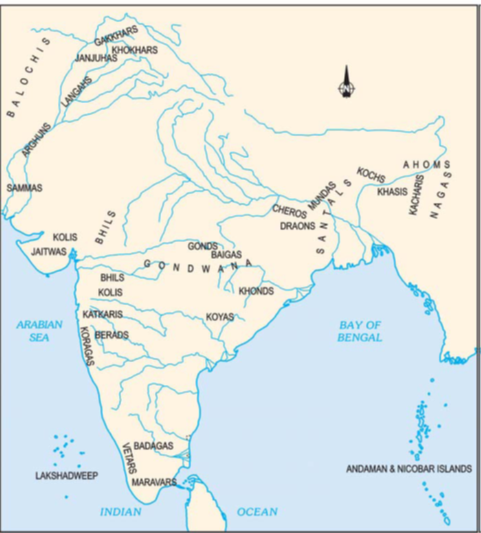
* Changing Society: New Castes and Hierarchies
* Changes in Varna System
1. As the economy and the needs of society grew, people with new skills were required.Smaller castes, or jatis, emerged within varnas. Many tribes and social groups were taken into caste-based society and given the status of jatis.
2. Specialised artisans - smiths, carpenters and masons-were also recognised as separate jatis by the Brahmanas Jatis, rather than varna, became the basis for organising society.
3. Among the Kshatriyas, new Rajput clans became powerful by the eleventh and twelfth centuries. They belonged to different lineages, such as Hunas, Chandelas, Chalukyas and others.
4. The leading tribal families could join the ruling class. A large majority joined the lower jatis of caste society.
5. On the other hand, many dominant tribes of Punjab, Sind and the North-West Frontier had adopted Islam quite early. They continued to reject the caste system. The unequal social order, prescribed by orthodox Hindusim, was not widely accepted in these areas.
* A Closer Look
The Gonds
(i) The Gonds lived in a vast forested region called Gondwana - or “country inhabited by Gonds”.
(ii) They practised shifting cultivation.
(iii) The large Gond tribe was further divided into many smaller clans. Each clan had its own raja or rai.
Administration:
(i) The administrative system of these kingdoms was becoming centralised.
(ii) The kingdom was divided into garhs.
(iii) Each garh was controlled by a particular Gond clan.
(iv) This was further divided into units of 84 villages called chaurasi.
(v) The chaurasi was subdivided into barhots which were made up of 12 villages each.
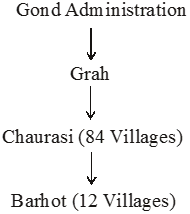
* Society and Royalty
(i) Brahmanas received land grants from the Gond rajas and became more influential.
(ii) The Gond chiefs now wished to be recognised as Rajputs.
(iii) So, Aman Das, the Gond raj of Garha Katanga, assumed the title of Sangram Shah. His son, Dalpat, Married princess Durgawati, the daughter of Salbahan, the Chandel Rajput raja of Mahoba.
(iv) Dalpat, however, died early.
(v) Rani Durgawati was very capable, and started ruling on behalf of her five-year-old son, Bir Narain. Under her, the kingdom became ever more extensive. In 1565, the Mughal forces under Asaf Khan attacked Garha Katanga. A strong resistance was put up by Rani Durgawati.
(vi) She was defeated and preferred to die rather than surrender. Her son, too, died fighting soon after.
* Garha Katanga: Rich State:
(i) Garha Katanga was a rich state.
(ii) It earned much wealth by trapping and exporting wild elephants to other kingdoms.
(iii) When the Mughals defeated the Gonds, they captured a huge booty of precious coins and elephants.
(iv) They annexed part of the kingdom and granted the rest to Chandra Shah, an uncle of Bir Narain.
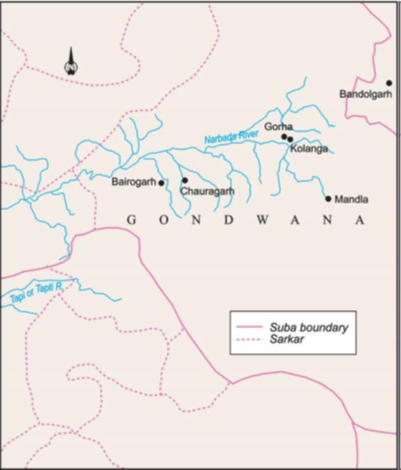
* The Ahoms
Establishment of Ahom State
(i) The Ahoms migrated to the Brahmaputra valley from present-day Myanmar in the thirteenth century. They created a new state by suppressing the older political system of the bhuiyans (landlords).
(ii) During the sixteenth century, they annexed the kingdoms of the Chhutiyas (1523) and of Koch-Hajo (1581) and subjugated many other tribes.
(iii) In 1662, the Mughals under Mir Jumla attacked the Ahom kingdom.
(iv) Despite their brave defence, the Ahoms were defeated.
(v) But direct Mughal control over the region could not last long.
Administration
(i) The Ahom state depended upon forced labour. Those forced to work for the state were called paiks.
(ii) A census of the population was taken.
(iii) Each village had to send a number of paiks by rotation.
(iv) People from heavily populated areas were shifted to less populated places.
(v) Ahom clans were thus broken up.
(vi) By the first half of the seventeenth century the administration became quite centralised.
(vii) Almost all adult males served in the army during war.
(viii) At other times, they were engaged in building dams, irrigation systems and other public works.
(ix) The Ahoms also introduced new methods of rice cultivation.
Society
(i) Ahom society was divided into clans or khels.
(ii) There were very few castes of artisans, so artisans in the Ahom areas came from the adjoining kingdoms.
(iii) A khel often controlled several villages.
(iv) The peasant was given land by his village community.
(v) Even the king could not take it away without the community’s consent.
Religion
(i) Originally, the Ahoms worshipped their own tribal gods.
(ii) During the first half of the seventeenth century.
(iii) However, the influence of Brahmanas increased. Temples and Brahmanas were granted land by the king. In the reign of Sib Singh (1714-1744), Hinduism became the predominant religion.
(iv) But the Ahom kings did not completely give up their traditional beliefs adopting Hinduism.
(v) Ahom society was very sophisticated.
(vi) Poets and scholars were given land grants.
(vii) Theatre was encouraged.
(viii) Important works of Sanskrit were translated into the local language.
(ix) Historical works, known as buranjis, were written-first in the Ahom language and then in Assamese.
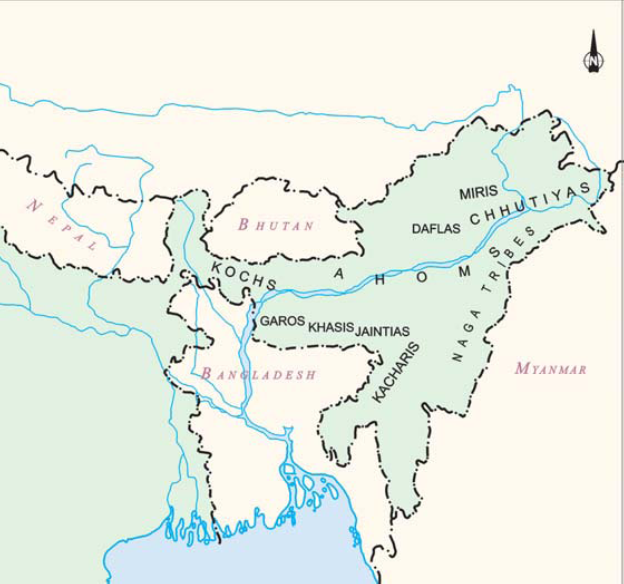
Illustration 1: Which area is the home to the Ahoms?
Solution:
The Ahoms ruled parts of present-day Assam for nearly 600 years, from 1228 to 1826. Historical documents do not call the kingdom “Ahom”. They call it “Asam” (or Assam), and the subjects of this kingdom “Assamese or Asmiya”.
Illustration 2: What did Jahangir write about Banjaras in his memoirs ?
Solution:
Jahangir wrote that Banjaras carried grain on their bullocks from different area and sold it in towns. They transported food grain for the Mughal army during military campaigns.

 Param Publication
Param Publication
